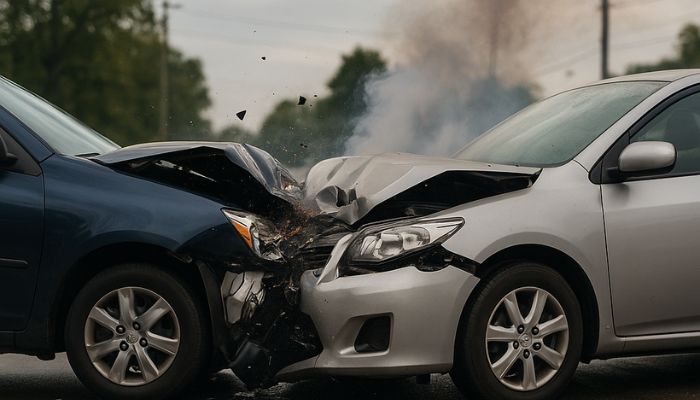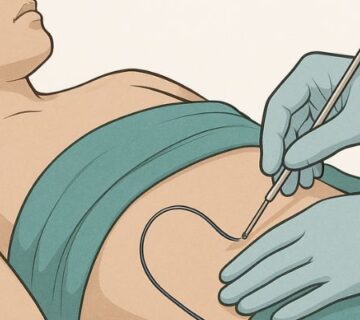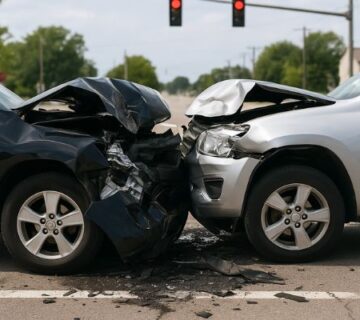Whether it’s a sudden jolt or a high-speed collision, car accidents can turn up our lives in more ways than one. While the immediate concern often revolves around the condition of your vehicle, the injuries these crashes leave behind can have lasting effects on your health and daily life. From common conditions like whiplash and concussions to more severe issues such as spinal fractures or internal bleeding, the physical toll can be intensive. What’s more, many injuries might not even show symptoms right away, making it crucial to understand the warning signs and long-term risks.
This guide takes a closer look at the different types of motor vehicle injuries, their symptoms, and the importance of seeking timely medical attention. By becoming more informed, you’ll not only be better prepared to address any injuries but also take steps to protect your health and overall well-being after an accident.
Table of contents
- Head Injuries due to Motor Vehicle Accidents
- Neurological Injuries due to Motor Vehicle Crash
- Common Back and Spine Injuries due to Motor Vehicle Accident
- Common Internal and Hidden Injuries due to Motor Vehicle Collision
- Psychological and Emotional Injuries After a Car Accident
- When to See a Doctor After a Motor Vehicle Accident
- Prevention Strategies for Motor Vehicle Crash
Head Injuries due to Motor Vehicle Accidents
Car accidents can result in several kinds of head injuries, ranging from minor to complicated ones. Here’s an overview of common head injuries and their symptoms.
Concussions
A concussion happens when your brain shifts rapidly inside the skull, often due to a sudden hit or jolt. This is one of the most common injuries in car accidents, even if your head doesn’t directly hit something. Symptoms include:
- Headaches
- Dizziness
- Confusion or feeling “foggy”
- Blurred vision
- Sensitivity to light or noise
Concussions are usually mild but can still lead to longer-term complications if untreated.
Brain Contusions
This involves bruising of the brain tissue, often from a direct effect on the head. Contusions can cause:
- Persistent headaches
- Drowsiness
- Confusion
- Difficulty concentrating
- Severe cases may require surgery to relieve pressure from bleeding.
Skull Fractures
A skull fracture occurs when the bones of the skull crack or break. Symptoms can include:
- Severe head pain
- Swelling or tenderness at the injury site
- Clear fluid leaking from the nose or ears (a sign of cerebrospinal fluid leakage)
- Dizziness or blurred vision
Diffuse Axonal Injury (DAI)
This type of injury happens when the brain twists or shifts inside the skull due to a car crash’s violent forces. DAI can disrupt nerve connections in the brain, leading to:
- Loss of consciousness (leading to coma)
- Dizziness
- Trouble speaking or understanding
- Difficulty with coordination
Hematomas and Hemorrhages
These involve bleeding in or around the brain. A hematoma creates pressure inside the skull, while a hemorrhage indicates active bleeding. Symptoms might include:
- Intense headaches
- Repeated vomiting
- Seizures
- Loss of coordination
Penetrative Head Injuries
When debris or glass pierces the skull, there’s a direct risk of injuries to brain tissue. Signs include bleeding, loss of function, and severe trauma. Immediate surgical care is essential to prevent fatal outcomes.
Neurological Injuries due to Motor Vehicle Crash
Motor vehicle accidents can lead to various neurological injuries, impacting the brain, spinal cord, and nerves.
Nerve Damage
Nerve injuries can affect either the central nervous system (the brain and spinal cord) or the peripheral nervous system (nerves throughout the body). Key examples include:
- Neuropathy: This involves damage to peripheral nerves, leading to numbness, tingling, or weakness in the hands and feet. Symptoms might disrupt daily tasks like walking or holding objects.
- Radiculopathy: Compression or damage to nerves as they exit the spinal column causes radiating pain, numbness, or weakness in the back, arms, or legs. This is commonly seen in the neck or lower back following trauma.
- Spinal Cord Injury: High-impact collisions may damage the spinal cord, leading to partial or complete paralysis, loss of sensation, or impaired motor function.
Common Back and Spine Injuries due to Motor Vehicle Accident
Whiplash
Whiplash commonly occurs in rear-end collisions. When the neck is jerked forward and backward rapidly, it can strain or tear muscles, ligaments, and tendons in the cervical spine. While it primarily affects the neck, whiplash may also cause upper back pain and stiffness. Symptoms often include neck pain, headaches, reduced range of motion, and tenderness in the upper back or shoulders.
Muscle Strains and Sprains
The sudden impact of a car accident can overextend the muscles, ligaments, or tendons in the back, leading to strains or sprains. These injuries might cause stiffness, swelling, tenderness, or difficulty moving. You may also experience muscle spasms, which are sudden, painful contractions of the muscles.
Herniated Discs
A herniated disc happens when one of the cushioning discs between your vertebrae is pushed out of place or ruptures. This condition often compresses nearby nerves, causing symptoms like lower back pain, tingling or numbness in the legs, or sharp pain that radiates down one side of the body (commonly known as sciatica). If it occurs in the neck, it may cause similar sensations in the arms or hands.
Spinal Fractures
The force of a collision can cause fractures in the vertebrae, particularly in the thoracic (middle back) or lumbar (lower back) regions. Symptoms of spinal fractures include severe back pain, swelling, and bruising. If the fractures impact nerves, you may experience numbness, weakness, or even loss of function below the injured area.
Facet Joint Injuries
Facet joints connect your vertebrae, allowing your spine to move and bend. A car accident can injure these joints, leading to inflammation, stiffness, and pain. Symptoms include tenderness around the joints and localized pain that may worsen with twisting or bending.
Degenerative Disc and Spine Conditions
The trauma from an accident can accelerate pre-existing degenerative issues like spinal osteoarthritis, spondylolisthesis (slipped vertebrae), or degenerative disc disease. These conditions typically cause chronic pain, limited mobility, and stiffness over time.
Common Internal and Hidden Injuries due to Motor Vehicle Collision
Internal Bleeding
Internal bleeding happens when blood vessels are damaged during a crash. This isn’t always visible on the outside but can be life-threatening. Warning signs include severe bruising, swelling, dizziness, extreme fatigue, or even fainting. If someone feels lightheaded or notices unusually dark or purple spots under the skin, they should seek immediate medical care.
Organ Damage
A violent hit can harm vital organs like the liver, spleen, or kidneys. Signs of organ damage may include abdominal pain, nausea, vomiting, or difficulty in breathing. Some people also experience symptoms like a tender or swollen stomach.
Psychological and Emotional Injuries After a Car Accident
1. Post-Traumatic Stress Disorder (PTSD)
Experiencing or witnessing a traumatic event like a car accident can lead to PTSD. Those affected may relive the incident through flashbacks or nightmares, feel extreme anxiety when thinking about driving, or avoid places or situations that remind them of the crash. For some, even the sound of honking or screeching tires might bring on an overwhelming emotional response.
2. Depression
Feelings of sadness or hopelessness are common after an accident, especially if someone is left coping with pain, physical limitations, or a significant lifestyle change. Depression might lead to a lack of motivation, disrupted sleep patterns, or loss of interest in things once enjoyed. Sometimes, individuals experience persistent guilt, even if the accident wasn’t their fault.
3. Anxiety and Driving Phobias
After an accident, some people find it hard to get back behind the wheel. This may range from mild discomfort to full-blown driving phobia, where the fear of being in a car can feel unmanageable.
4. Intrusive Thoughts and Flashbacks
Many accident survivors struggle to “turn off” their minds. They may frequently think about what happened, replay the accident in their heads, or wonder if they could have done something differently. For others, certain triggers like smells, songs, or visual cues can take them right back to the traumatic moment.
5. Social Isolation
The emotional toll of a crash can push some people to pull away from family and friends. They may feel misunderstood or unwilling to burden loved ones with their struggles, leading to loneliness and further detachment.
6. Sleep Disturbances
Accident victims often experience sleep problems. This includes difficulty falling or staying asleep, frequent nightmares, or, in some cases, sleeping too much to escape emotional pain. Poor sleep only exacerbates feelings of fatigue and irritability.
When to See a Doctor After a Motor Vehicle Accident
Immediate Symptoms to Watch For
After an accident, it’s crucial to seek medical attention if you experience certain symptoms right away. Signs like severe pain, visible injuries such as deep cuts or fractures, difficulty breathing, chest pain, or loss of consciousness call for an immediate medical care at the hospital. These could point to serious issues like internal bleeding, broken ribs, or brain injuries.
Delayed Symptoms That Need Attention
Sometimes, injuries don’t show up immediately. Symptoms like persistent headaches, neck or back pain, numbness or tingling, or unexplained nausea can develop hours or even days after the accident. These signs could indicate whiplash, nerve damage, or even a concussion. Always listen to your body. If something doesn’t feel right in the days following the accident, visit the hospital as soon as possible.
Why Timely Care Matters
Getting a prompt medical evaluation not only helps address injuries before they worsen but also ensures a thorough record of your condition. This documentation can be crucial if you’re dealing with insurance claims or legal actions down the line. Delays in care might give insurers the chance to argue that your injuries aren’t related to the accident.
Prevention Strategies for Motor Vehicle Crash
- Practice Defensive Driving
Stay alert and anticipate the actions of other drivers. This includes maintaining a safe following distance, scanning your surroundings, and preparing for unexpected maneuvers. Defensive driving reduces the risk of rear-end collisions and other accidents caused by sudden moves. - Eliminate Distractions
Distracted driving is a leading cause of accidents. Keep your focus on the road by avoiding mobile devices, eating, or any activity that pulls your attention away from driving. - Adhere to Traffic Laws
Obeying speed limits, stopping at lights and signs, and respecting right-of-way rules are basic but crucial steps for preventing accidents. - Wear Your Seat Belt
Buckling up is one of the simplest yet most effective ways to stay safe. Make it a habit to wear a seat belt, and ensure all passengers do the same. It’s a small step that can significantly reduce the severity of injuries during an accident. - Avoid Driving Under the Influence
Impaired driving is extremely dangerous. Never drive under the influence of alcohol, drugs, or medications that affect your focus or coordination. Use rideshare services or designated drivers when needed. - Keep Up with Vehicle Maintenance
A well-maintained vehicle is safer to drive. Regularly check brakes, tire pressure, lights, and windshield wipers. Address any potential issues promptly to avoid mechanical failures that could lead to accidents. - Adjust Driving for Weather Conditions
Slippery roads, fog, or heavy rain require slower speeds and greater following distances. Take extra caution and drive more safely during adverse weather to maintain vehicle control. - Reduce Night Driving
Driving at night can be more dangerous due to reduced visibility. If you’re inexperienced or tired, consider limiting nighttime driving until you’re more comfortable behind the wheel. - Prepare for Emergencies
Keep a safety kit in your car and know how to handle common emergencies like flat tires or engine trouble. Being equipped with tools like a flashlight, jumper cables, and a first aid kit could help reduce further risks during breakdowns.
Motor vehicle injuries can have serious, lasting impacts, but understanding them is the first step toward recovery. Acting quickly and seeking medical care when needed can make all the difference. Prioritize your well-being, stay informed, and take steps to protect your health. Don’t wait—your health deserves immediate attention!
For the best pain management specialists in Dallas, please contact pain specialists at Texas Spine & Pain Institute.




No comment